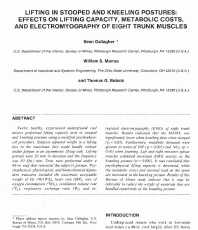Mining Publication: Lifting in Stooped and Kneeling Postures: Effects on Lifting Capacity, Metabolic Cost, and Electromyography of Eight Trunk Muscles
Original creation date: November 1988
Twelve healthy, experienced underground coal miners performed lifting-capacity tests in stooped and kneeling postures using a modified psychophysical procedure. Subjects adjusted weight in a lifting box to the maximum they could handle without undue fatigue in an asymmetric lifting task. Lifting periods were 20 min in duration, and the frequency was 10 lifts/min. Tests were performed under a 48-in roof that restricted the subject's posture. Psychophysical, physiological, and biomechanical dependent measures included the maximum acceptable weight of lift (mawl), heart rate (hr), rate of oxygen consumption (vo2), ventilation volume rate, respiratory exchange ratio, and integrated electromyography (EMG) of eight trunk muscles. Results indicated that mawl was significantly lower when kneeling than when stooped (p<0.05). Furthermore, metabolic demands were greater in terms of hr (p<0.005) and vo2 (p<0.05) when kneeling. Left and right erectores spinae muscles exhibited increased EMG activity in the kneeling posture (p<0.001). It was concluded that psychophysical lifting capacity is decreased, while the metabolic stress and internal load on the spine are increased, in the kneeling posture. Results of this Bureau of Mines study indicate that it may be advisable to reduce the weight of materials that are handled repetitively in the kneeling posture.
Authors: S Gallagher, WS Marras, TG Bobick
Peer Reviewed Journal Article - November 1988
NIOSHTIC2 Number: 10006601
Int J Ind Ergon 1988 Nov; 3(1):65-76
See Also
- Biomechanical Modeling of Asymmetric Lifting Tasks in Constrained Lifting Postures
- Characteristics of Gait in Restricted Vertical Space Versus Unrestricted Walking
- Effects of Lifting in Four Restricted Postures
- Effects of Posture on Back Strength and Lifting Capacity
- The Effects of Restricted Workspace on Lumbar Spine Loading
- Electromyography of the Thigh Muscles during Lifting Tasks in Kneeling and Squatting Postures
- Locomotion in Restricted space: Kinematic and Electromyographic Analysis of Stoopwalking and Crawling
- Torso Flexion Loads and Fatigue Failure Mode of Human Lumbosacral Motion Segments
- Trunk Extension Strength and Muscle Activity in Standing and Kneeling Postures
- Working in Unusual or Restricted Postures
- Content source: National Institute for Occupational Safety and Health, Mining Program


 ShareCompartir
ShareCompartir
